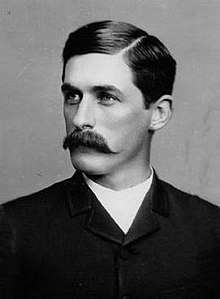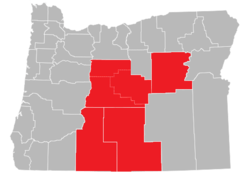Hazen A. Brattain
Hazen Adelbert Brattain (also known as H. A. Brattain; September 2, 1864 – September 21, 1930) was an American rancher, banker, and a state legislator from the state of Oregon. He served one term in the Oregon House of Representatives as a Republican legislator, representing a large and rural district in central and southern Oregon. He also was president of the First National Bank of Lakeview and operated a large cattle ranch in Lake County, Oregon.
Hazen A. Brattain | |
|---|---|
 Rancher and legislator H. A. Brattain | |
| Member of the Oregon House of Representatives from the 21st district | |
| In office 1909–1910 | |
| Preceded by | George H. Merryman |
| Succeeded by | W. Lair Thompson |
| Constituency | Crook, Grant, Klamath, and Lake counties |
| Personal details | |
| Born | September 2, 1864 Springfield, Oregon |
| Died | September 21, 1930 (aged 66) Paisley, Oregon |
| Political party | Republican |
| Profession | Rancher and banker |
Early life
Brattain was born in Springfield, Oregon on September 2, 1864, the son of Thomas Jefferson Brattain and Permelia Jane (Gillespie) Brattain. He was the third of four children. At the time of his birth, Brattain's father had a 300 acres (120 ha) farm in Linn County east of the Springfield town site. In 1869, his family moved to the Langell Valley in what is now Klamath County in southern Oregon. In 1873, the Brattain family moved east to the Chewaucan River valley, locating south of Paisley, Oregon. His father established a successful cattle ranch there. Brattain's father helped build the area's first school and later served on the Paisley school board.[1][2][3]
Brattain attended college in Eugene, Oregon, receiving a Bachelor of Arts degree from the University of Oregon in 1888. He then went on to earn Master of Arts from the university in 1893.[1][4]
When he finished his education, Brattain returned to Lake County where he helped run his family’s ranch. After his father’s death, Brattain entered into a partnership with his younger brother, Paul J. Brattain, to continue operating the family ranch. In addition to the ranch, Brattain had other business interests in Lake County. He was a director and then vice president of two local banking institutions, the First National Bank of Lakeview and the Lake County Loan and Savings Bank.[1][5][6]
Political career
The Brattain family actively supported the Republican Party and its candidates. In 1896, Brattain joined his father on the Lake County Republican central committee, representing the Chewaucan/Paisley area.[7]
In 1908, the Lake County Examiner began encouraging Brattain to run for a District 21 seat in the Oregon House of Representatives. The newspaper recommended Brattain because of his experience as a prosperous livestock rancher and successful banker.[8] Shortly after the Examiner began promoting Brattain for a seat in the state legislature, several other central Oregon newspapers picked up Brattain’s cause. They not only citing Brattain’s success in business, but his understanding of key issues relevant to citizens living in District 21 as reason for supporting him. They also highlighted his college education and personal popularity across the district.[9][10][11] As a result, Brattain, decided to run for a seat in the Oregon legislature.[12] In the Republican primary, Brattain and Horace P. Belknap were nominated for the two District 21 positions and then went on to win the two District 21 seats in the general election.[13][14][15]

Brattain took his seat in the Oregon legislative assembly when the 25th regular session was called to order on 11 January 1909. As a District 21 legislator, he represented a very large and rural district that included Crook, Grant, Klamath, and Lake counties. At that time, what are now Deschutes and Jefferson counties were part of Crook County. Together these counties covered over one-quarter of the land area of Oregon. During the session, he served on the banking, assessment and taxation, and alcoholic traffic committees. The 1909 session lasted six weeks, ending on 20 February.[8][16][17][18] A month later, Brattain and his fellow legislators were called back to the capitol for a two-day special session before adjourning for the remainder of the biennium.[19]
After the state legislature finished its session, Brattain continued to serve in various appointed positions. Governor Frank W. Benson named Brattain as a delegate to the 1909 National Irrigation Congress in Spokane, Washington.[20][21] A year later, Governor Jay Bowerman names him as delegate to the 1910 National Irrigation Congress, held in Pueblo, Colorado.[22] Brattain decided not to run for re-election and left office when his two-year term finished at the end of 1910.[23][24]
In 1920, after being out of the state legislature for a decade, Brattain once again ran for a District 21 seat in the Oregon House of Representatives.[25][26] Two other Republicans, Denton G. Burdick and Harley J. Overturf, also file for the two District 21 seats. Despite the competition, Brattain did not actively campaign for the position.[27][28] As a result, he lost the Republican primary to Burdick and Overturf, who went on to win the two District 21 seats in the general election.[29][30]
Later life
After leaving state politics, Brattain continued to manage his family ranch near Paisley. He also retained his bank positions, eventually becoming president of the First National Bank of Lakeview.[31] In addition, he served on the Oregon Cattle and Horse Raisers Association’s executive board.[32] The Lake County Examiner also raised Brattain’s name as a possible candidate for Lake County commissioner, but he decided not to run for that position.[33]
After the Nevada–California–Oregon Railway reached Lakeview, Brattain and other Lake County leaders actively engaged in an effort to persuade the railroad to extend its tracks north to Paisley. However, that effort proved unsuccessful.[34][35][36] In 1922, Brattain joined two partners to found the Chewaucan Private Electric Company to provide commercial electricity to the Paisley community.[37]
In 1930, Brattain took a seven month tour around the world. During his travels, Brattain crossed the Pacific Ocean, visiting Hawaii, Japan, Korea, China, Philippines, and Singapore. He then crossed the Indian Ocean, stopping at India and Ceylon before reaching the Suez Canal. He visited a number of sites in Egypt and the Holy Lands. Brattain then visited countries across Europe including Italy, France, Germany, England, Scotland, Wales, and Ireland before crossing the Atlantic Ocean to New York City. From New York, he drove across the United States to Los Angeles and then back to his home in Oregon.[2][38]
Brattain never married. He died on September 21, 1930 at his ranch near Paisley, just a month after returning from his around the world trip.[3] He was 66 years old at the time of his death. He is buried at the Odd Fellows cemetery in Paisley.[3]
References
- "Thomas Jefferson Brattain", Centennial History of Oregon 1811–1912 Illustrated (Volume IV), S. J. Clarke Publishing Company, Chicago, Illinois, 1912, p. 86-89
- "List of United States Citizens", New York Passenger and Crew Lists for S. S. Milwaukee departing Cork, Ireland for New York on 25 July 1930; citing NARA microfilm publication T715; Washington, DC: National Archives and Records Administration, 3 August 1930, accessed on 6 August 2017 via www.familysearch.org.
- "H. A. Brattain Dies at Paisley Home", Eugene Register, Eugene, Oregon, 22 September 1930, p. 2.

- 1988, General Register of the Officers and Alumni 1873–1913, University of Oregon, Eugene, Oregon, February 1914, p. 17.
- "Bank’s Annual Election", Lake County Examiner, Lakeview, Oregon, 16 January 1908, p. 1.
- Wright, Will, (Superintendent of Banks) "Lake County Loan and Saving Bank", Fourth Annual Report of the State Banking Department of the State of Oregon—1911, Willis S. Dunaway State Printer, Salem, Oregon, 1912, p. 63.
- "Lake County Central Committee", Record of the Republican Party in the State of Oregon, Republican Party Central Committee, Register Publishing Company, Portland, Oregon, 1896, p. 152.
- "Our Interests demand It, Lake County Examiner, Lakeview, Oregon, 16 January 1908, p. 1.
- "Lake is entitled to Office", Crook County Journal, Prineville, Oregon, 23 January 1908, p. 2.
- Untitled reprint of Lake County Examiner editorial endorsement, Madras Pioneer, Madras, Oregon, 27 February 1908, p. 4.
- "A Good Word for Brattain", reprint of Lake County Examiner editorial endorsement, Madras Pioneer, Madras, Oregon, 6 March 1908, p. 4.
- "Statement No. 1 Heads the List", Eastern Oregonian, Pendleton, Oregon, 6 April 1908, p. 8.

- "Legislature is Statement One", Morning Register, Eugene, Oregon, 4 June 1908, p. 3.

- "Members of Oregon Legislature", Morning Oregonian, Portland, Oregon, 4 June 1908, p. 6.
- "73 Republicans; 13 Democrats", Statesman Journal, Salem, Oregon, 4 July 1908, p. 6.

- "1909 Regular Session (25th): January 11 – February 20", Oregon Legislators and Staff Guide, Oregon State Archives, Salem, Oregon, accessed 6 August 2017.
- "M’Arthur has Appointed the House Committees", Oregon Daily Journal, Portland, Oregon, 18 January 1909, p. 3.(subscription required)
- "Committees of House Named", Statesman Journal, Salem, Oregon, 19 January 1909, p. 6.(subscription required)
- "1909 Special Session (25th): March 15 – 16", Oregon Legislators and Staff Guide, Oregon State Archives, Salem, Oregon, accessed 6 August 2017.
- "Oregon State Items of Interest", Enterprise News-Record, Enterprise, Oregon, 14 July 1909, p. 2.
- "Portland men Appointed", Morning Oregonian, Portland, Oregon, 2 September 1909, p. 5.
- "Delegates are Selected", Statesman Journal, Salem, Oregon, 2 September 1910, p. 6.(subscription required)
- "No Opposition to Assembly in 17 Oregon Districts", Oregon Daily Journal, Portland, Oregon, September 17, 1910, p. 3.(subscription required)
- "1911 Regular Session (26th): January 9 – February 18", Oregon Legislators and Staff Guide, Oregon State Archives, Salem, Oregon, accessed 6 August 2017.
- "Republican Ballot to be Loaded with Candidates Names; Nine More File", Capital Journal, Salem, Oregon, 3 April 1920, p. 1.
- "Flegel Would Attend Meet to Vote for W. G. M’Adoo", Oregon Daily Journal, Portland, Oregon, 4 April 1920, p. 3.(subscription required)
- "Paisley Man is in Race", Sunday Oregonian, Portland, Oregon, 4 April 1920, p. 8.
- "Political Honors Sought by 346 of Oregon’s Citizens", Oregon Daily Journal, Portland, Oregon, 18 April 1920, p. 8.(subscription required)
- "Contest Close in Legislative Ticket", Morning Oregonian, Portland, Oregon, 24 May 1920, p. 6.
- "Overturf High for House", Bend Bulletin, Bend, Oregon, 25 May 1920, p. 1.(subscription required)
- "More or Less Personal Random Observations Around Town", Oregon Daily Journal, Portland, Oregon, 22 August 1922, p. 8. via – Newspapers.com

- "Stock Association Executives Close Convention Trip", Oregon Daily Journal, Portland, Oregon, 17 September 1920, p. 8. via – Newspapers.com

- "Political Pot Starts", Lake County Examiner, Lakeview, Oregon, 5 February 1914, p. 1.
- "N-C-O Plans Extension", Lake County Examiner, Lakeview, Oregon, 23 May 1912, p. 1.
- "Paisley Expects Road", Sunday Oregonian, Portland, Oregon, 2 June 1912, p. 11.
- Moore, Jeff, "Nevada-California-Oregon Railroad", High Desert Rails Railroading in Oregon's Outback, trainweb.org/highdesertrails, accessed 4 December 2017.
- "Hospital Society Field", Morning Oregonian, Portland, Oregon, 21 February 1922, p. 6.
- "Travels are Told", Eugene Register, Eugene, Oregon, 5 March 1930, p. 7. via – Newspapers.com
